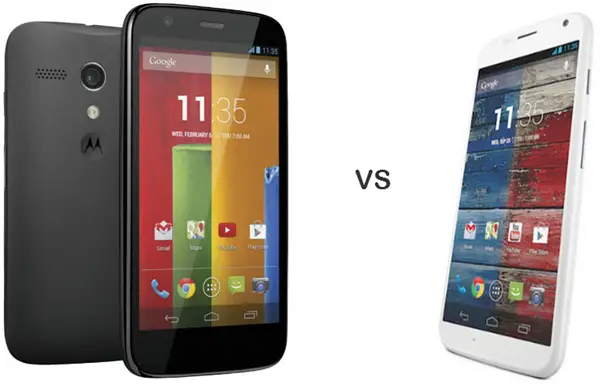Display and Processor
The Moto G has a slightly smaller 4.5 Inch IPS Lcd display which Motorola claims is the highlight of this smartphone, it gives you pixel density of 326 ppi which is amazing considering the price range. The Moto X on the other hand comes with a super AMOLED display which will give you darker darks and will be more suited for multimedia experience. The AMOLED displays consume less battery and thus Motorola had to provide it in Moto X or else the Active display features in Moto X would have taken heavy toll on the battery. The Moto G does not have Active display and always on voice command. The Snapdragon 400 chipset present in Moto G comes with 4 Cortex A7 cores instead of faster Krait 300 cores which are also more power efficient. The Cores are clocked at 1.2 GHz and Motorola makes tall performance claims with this device. The GPU present is Adreno 305. The Moto X carries smoothly on 2 Krait 300 cores present in Qualcomm MSM8960Pro Soc clocked at 1.7 GHz. A contextual awareness core and 1 natural language core is also present for active display and always on Voice features. Together with Adreno 320 GPU which will provide 50 percent performance boost with respect to Adreno 305 in Moto G this forms the X8 computing system in Moto X.
Camera and Memory
The Moto X has a 10 MP camera at the back which is supported by LED flash. The pixel size is 1.4 micrometer which is bigger than a conventional pixel and will provide with better low light performance by absorbing more light. A front camera of 2 MP is also present and both of these cameras are capable of Full HD 1080p video recording. The Moto G on the other hand sports only 5 MP AF camera at the back and a 1.3 MP camera at the front. Both of these cameras are capable of 720p HD video recording and thus, the camera has been heavily trimmed down in the budget device. The Memory in both of these devices is not extendable. The Moto X was released in 16 GB/ 32 GB variants where as Moto G will be available in 8 GB/ 16 GB variants which is again one step down for reducing the cost according to the targeted markets.
Battery and Features
The Battery capacity of Moto X is 2200 mAh which will provide you with up to 13 hours of talk time and 576 hours of standby time. With Active display and Voice commands on, your battery will struggle to last one day. The Moto G claims a full day of backup on its 2070 mAh battery. The battery life of both of these phones will be satisfactory and we don’t expect much difference in this segment. Both Moto X and Moto G will offer you customized back cover. The Moto X will offer you more customization options including your first boot wallpapers and engravings. The Moto X provides you the option to buy various back covers as accessories and replace them at your will. The Active display on Moto X lights up when you take the phone out of your pocket/ Purse or when you flip it over on a table. The lit up screen will show a digital clock and icon of the App you got notification from. You can slide up the icon to view the notification or even discard it. The Always on Voice command in Moto X works similar to Google’s experience launcher and you have to say OK Google to open the Google Now interface. Both of these phones will feature Android 4.4 Kitkat operating system and as Google has acquired Motorola you can expect timely updates.
Key Specs
Conclusion
Moto X is far ahead in most respects but the price difference does matters. Moto G will give you most value for money and with a fast quad core processor, Latest software and a brilliant LCD display – it has got all boxes checked to make it a success in markets like India, which are still filled with yesteryear hardware and Chinese rebranded phones. The Moto X on the other hand will be a worthy competitor in the mid range segment.
